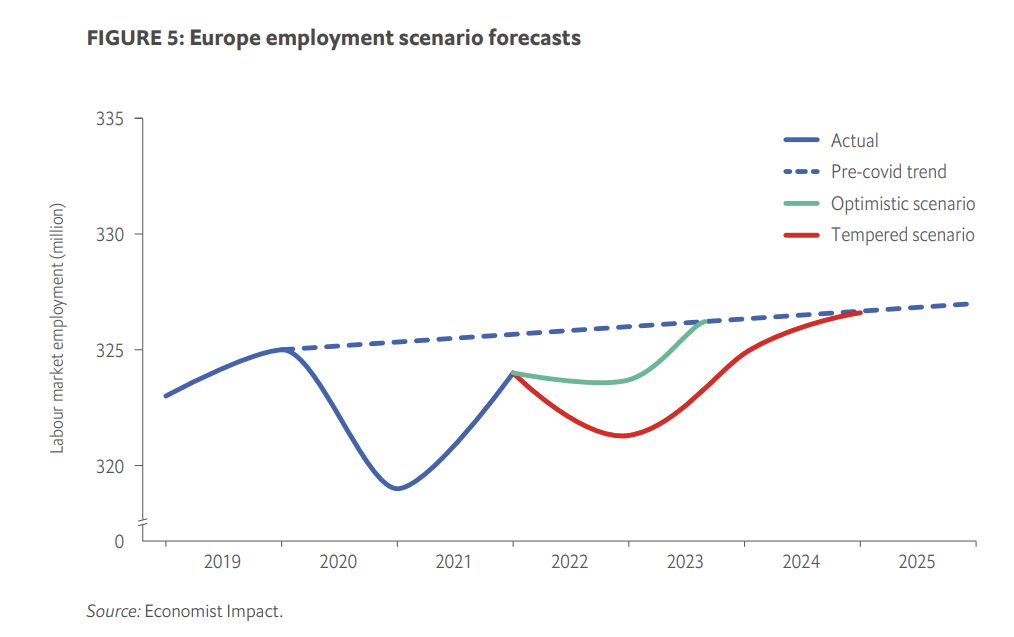By Coram Williams
CFO and Chief Economist
The two-plus years since the onset of Covid-19 have been marked by turmoil. There is the pandemic itself, of course — which appears to be under control, but I cross my fingers as I say that. But Covid-19 had longer lasting effects, driving the Great Resignation or Great Reevaluation. Though employment plummeted during pandemic-related shutdowns, it roared back in 2021, fueled by economic stimulus packages, vaccines, the opening of borders, and other factors — resulting in an acute labour market imbalance.
More recently, though, war in Ukraine has roiled the world in both humanitarian and fiscal terms, and the worst economic contraction in two generations is being felt.
When I speak with business leaders, the labour shortage is inevitably their uppermost concern. They know that big-picture demographic trends are not in their favour, and their first question is as fundamental as it is urgent: Will there be enough people, with the necessary skills, to get my organisation’s work done?
Together with Economist Impact, the Adecco Group recently developed employment forecasts that break down the labour market outlook at both global and regional levels. Keep in mind that Covid-19 hit markets in different ways, so regional recovery paths should be expected.
Many discussions around employment focus on when levels will return to their pre-Covid state. But we believe the focus should instead be when employment levels will return to the pre-Covid trend — that is, where levels would have been now if Covid-19 hadn’t struck.
Economist Impact expects the global labour market to fully recover from Covid-19 by next year. Regionally, however, myriad factors could delay this recovery. For example, before the war in Ukraine, employment in Europe was expected to recover in 2022. Now, taking into account the impact of the war, our forecasts suggest that European employment could recover in 2023 in an optimistic scenario, with a downside scenario forecasting recovery in 2024.

To be sure, certain categories of workers are scarce virtually everywhere. A category we call “skilled non-professional” (think welders and machinists), for example, is in extreme demand worldwide as economies recover.
While the most difficult positions to fill vary by region and industry, the generally tight labour market is a reality for the foreseeable future in many parts of the world. Business leaders must respond accordingly.
Leading in a time of scarcity
Leadership entails constantly forming and revising strategic scenarios. Given facts on the ground today, I propose that a workforce planning scenario must be a key component of the larger strategic scenario. Here are some thoughts on how organisations can thrive while improving workers’ lives:
-
Focus on resilient, flexible operating models. Many complex factors have combined to create today’s labour situation, including the Ukraine crisis, Covid-19 and inflation. Organisations mustn’t let this list overwhelm them. By maintaining the focus on resilient, flexible operating models that emerged during Covid-19, and adapting to cope with ongoing uncertainty, it’s possible to forge a successful path forward. Indeed, by pushing leaders to be more agile in their staffing efforts, I believe lessons learned in the pandemic offer leading organisations a chance to distance themselves from less resilient competitors.
-
Understand the workforce at a skills level and embrace the entire talent pool. At the Adecco Group, we have long advocated reskilling and upskilling workers — and I believe today’s labour shortage underscores the wisdom of this approach. Going forward, leaders must take the time and effort to understand skills data in order to better position, develop and upskill all workers. This will entail such strategies as offering ‘returnships’ after parental leave or absence due to long-term sickness. In a time of labour scarcity, this type of creative thinking will be necessary.
Leaders often ask about the value of automation. My response is that automating certain rote tasks will increasingly be a competitive necessity. But the focus shouldn’t be headcount alone; automation should free human workers to focus on high-value-add tasks, and those workers must be treated with respect when an organisation designs and implements human-machine processes.
To manage the complex workforce of today (and tomorrow) in a tumultuous time of scarcity, organisations should integrate scenario analysis into their strategic workforce planning in order to keep up with uncertainty and regional labour market differences. Companies can maximise efficiency and effectiveness around sourcing and positioning talent by starting with a skills-based approach and having clarity on which skills are essential, in which regions, and when. Finally, businesses should plan when and where reliable and consistent access to people and skills is needed, and where flexibility can be leveraged to tackle uncertainty.
-
Pay attention to new workforce expectations. It’s no secret that labour scarcity has shifted the balance of power from employer to employee. Higher salaries are one obvious outgrowth of this shift, but there are others. From true flexible working models, to bringing pets to the office, to demanding that their company actively participate in social movements, workers will not be satisfied with mere pay raises. The Adecco Group surveyed 15,000 workers to understand their priorities, and we learned that maintaining a good work-life balance is just as important as salary. Career development; up- and reskilling opportunities; feeling trusted; leaders who exercise empathy; and a company with great purpose are also key components for an engaged, loyal workforce.
While this new reality may initially feel confusing, even overwhelming, I urge organisations to view labour’s new power as a win-win opportunity. Leaders can contribute to a healthier, more productive global workforce — and, in the process, improve the bottom line. That is, they can do well by doing good.
To learn more, Watch the "Impact of talent scarcity on the future of work" webinar below.
This panel discussion includes new research from Economist Impact regarding a Talent Scarcity/Wage Inflation scenario analysis to be discussed and shared with participants.



